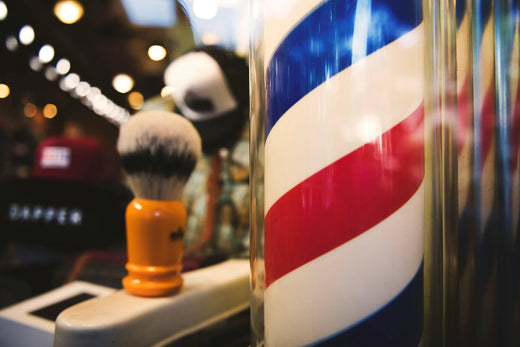
Barber Shop Pole: History Behind the Iconic Spinning Symbol
Share
A barber shop pole is a classic symbol of barbershops and has a long history dating back to the Middle Ages. The red, white, and blue stripes on the pole represent bloodletting, bandages, and veins, which were common practices in early barber shops. Today, the barber shop pole is a recognizable symbol of barbering and is often displayed outside of barber shops to attract customers.
Historical Origins

The significance of the barber pole in the barbering industry can be traced back to its origins in the Middle Ages. During this time, barbers not only cut hair and shaved beards, but also performed surgical procedures and tooth extractions. The red and white stripes on the pole represented blood and bandages, while the blue symbolized veins, reflecting the barber's multifaceted role as both a haircutter and a medical practitioner. As the barber pole evolved into a symbol of the trade, it became a recognizable fixture outside of barbershops, attracting customers with its nostalgic charm and timeless appeal.
Association with bloodletting and the medical profession continued to be a significant aspect of the barber pole's symbolism, even as the practice of bloodletting fell out of favor. The traditional red and white stripes remained a prominent feature, serving as a reminder of the barber's historical connection to medicine.
Over time, the barber pole became not just a sign of a place to get a haircut, but a symbol of tradition, expertise, and trust in the hands of a skilled practitioner. Customers would seek out barbershops adorned with the iconic pole, knowing that they would receive quality service and care in a familiar and comforting environment.
Modern Interpretations
Some modern interpretations of the barber pole have incorporated new colors and designs to reflect the diversity and creativity of contemporary barbershops. Despite these updates, the barber pole continues to serve as a symbol of tradition and professionalism in the grooming industry. Its iconic presence outside of barbershops around the world is a reminder of the enduring legacy of this time-honored profession.

Adaptations of the symbol for modern barbering establishments can be seen in various designs and colors, but the essence of tradition and professionalism remains intact.
One adaptation of the traditional barber pole for modern barbering establishments is the use of sleek, minimalist designs that fit in with the aesthetic of contemporary salons. Some barbershops have also taken a more creative approach by incorporating the barber pole into their logo or branding, using it as a symbol of their commitment to quality grooming services.

In pop culture, the barber pole has made appearances in various forms, from being featured in movies and television shows to being used as a design element in fashion and accessories. Its presence in popular culture further solidifies its status as a timeless symbol of the barbering profession.
Conclusion
Overall, the barber pole holds a significant place in the history and culture of barbering, serving as a symbol of tradition, quality, and professionalism. Whether it's displayed outside a traditional barbershop or incorporated into the branding of a modern salon, the barber pole continues to be a recognizable and iconic emblem in the world of grooming.
As barbershops evolve and adapt to changing trends, the barber pole remains a constant reminder of the timeless artistry and craftsmanship that defines the profession. Its enduring presence in both physical establishments and popular media reinforces its status as a symbol that transcends time and trends, connecting barbers past and present in a shared legacy of excellence.
